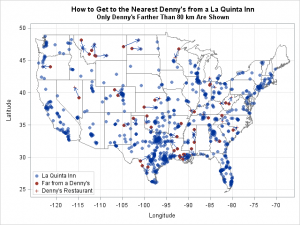

Mutate(big = if_else(POPULATION >= 40000, TRUE, FALSE)) What looks like France if we separate cities with this 40000 inhabitants limit? # France data

), only cities upper than 40000 inhabitants are represented, along with all capital cities of any population size (and some other smaller towns). # remotes::install_github("JohnCoene/globe4r")įont <- extrafont::choose_font(c("Nanum Pen", "Lato", "sans")) # remotes::install_github('JohnCoene/echarts4r.maps') I want to calculate the distance using latitudes and longitudes but it should exactly replicate the outcome of GEODIST function for the same input of latitudes and longitudes. One limitation of Tableau, however, is that it can only plot data by Provinces in Vietnam, while many of the projects required data to be illustrated by Districts.# remotes::install_github('JohnCoene/echarts4r.assets') One of our options was Tableau and its Map function (Source: Tableau). Before I knew Python, it was a very challenging task to plot data on a map. One of the topic that I have been encountering very frequently in my jobs was working with geographical data. I have been coding since then and now I am teaching at the same school where I learnt my first line of code. distclstr <-plotgeodist (ptsclustered, co, sampling 'Fibonacci', cvfolds randomfolds, unit 'km', showPlot FALSE) distclstr plot + scalexlog10 (labels round) Obviously the CV folds are not representative for the prediction locations (at least not in terms of distance to a nearest training data point). Nevertheless, being frustrated with Excel constantly crashing, I gave it a try anyway and OMG, it was mind blowing. To someone with a business background like me, coding felt like rocket science and it was not something that I thought I would be interested in. cowplot:: plotgrid(ot, ot, relwidths c(.7, 1)) Here we see that the median NTI value for agriculture and meadow soils are below -2 indicating that phylogenetic turnover in land use strategies is significantly lower than expected by chance. If you are unfamiliar with pandas and matplotlib. Geoplot, similarly, is built on top of matplotlib for cartographic plots. Geopandas is based on pandas and extends its features to allow manipulating geometric data type. I was looking out to learn some new tools for my works and I found a Data Analysis with Python course at CoderSchool. Geopandas and Geoplot are two Python libraries that allow us to handle and visualize geographical data.
#GEODIST PLOT UPDATE#
It could easily take a whole morning just to update a few spreadsheets as the performance of Excel quickly deteriorates when working with large data. But for such a fast-growing industry with millions rows of new data flowing in every day, Microsoft Excel was hardly sufficient to get the job done. My job involved lots of data and spreadsheets to store and analyze it. Library sp allows for sampling points in a delimited SpatialPolygons which was exactly what I was looking for. Note, that 0 and 1 are enclosed in inverted commas since the type of all three drug variables is a string for now. I first thought about plotting emoji on a regular point pattern sampled in the polygon. In order to convert these strings to binary codes, we can individually replace each string for each drug variable as follows: replace drugA'1' if drugA'yes' replace drugA'0' if drugA'no'.

#GEODIST PLOT HOW TO#
Traveling back to February 2019, I had been working as a researcher for a media company. Plot an image pattern in a delimited polygon Symbology for mapping with R A question on stackoverflow asked how to draw trees in a polygon to represent a forest area on a map.


 0 kommentar(er)
0 kommentar(er)
